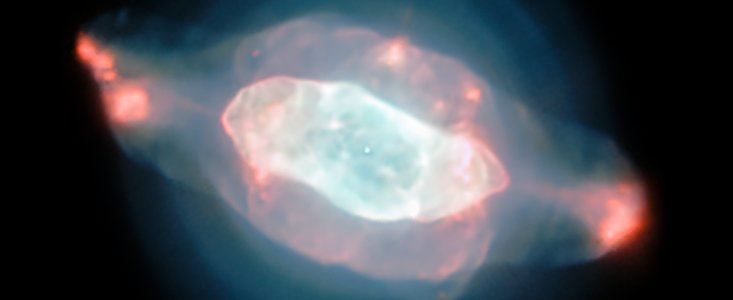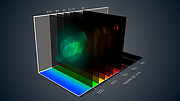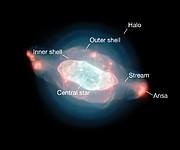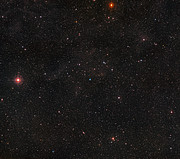Comunicato Stampa
Le strane strutture della Nebulosa Saturno
27 Settembre 2017
La spettacolare nebulosa planetaria NGC 7009, nota anche come Nebulosa Saturno, emerge dall'oscurità come una serie di bolle deformate, illuminate di magnifici rosa e blu. Questa immagine variopinta è stata ottenuta dello strumento MUSE montato sul VLT (Very Large Telescope) dell'ESO, nell'ambito di uno studio inteso a realizzare per la prima volta una mappa della polvere all'interno di una nebulosa planetaria. La mappa - che mostra numerose strutture intricate nella polvere, tra cui alcuni gusci, un alone e una strana struttura che ricorda un'onda - sarà un riferimento per gli astronomi che vogliono capire come le nebulose planetarie svilupano le loro strane forme e le loro simmetrie.
La Nebulosa Saturno si trova a circa 5000 anni luce dalla Terra, nella costellazione dell'Acquario, e prende il nome dalla sua strana forma che assomiglia al famoso pianeta con gli anelli visto di taglio.
In realtà, le nebulose planetarie non hanno nulla a che fare con i pianeti. La Nebulosa Saturno in origine era una stella di piccola massa, che si è espansa fino a diventare una gigante rossa al termine della propria vita e ha iniziato a rilasciare gli strati più esterni. Questo materiale è stato soffiato via da forti venti stellari e eccitato dalla radiazione ultravioletta del nucleo stellare caldissimo rimasto al centro del sistema, creando così una nebulosa circumstellare di polvere e gas caldo dai colori brillanti. Nel cuore della Nebulosa Saturno rimane ancora la stella ormai condannata, la piccola macchia centrale visibile nell'immagine, che si sta trasformando in una nana bianca [1].
Per capire meglio come le nebulose planetarie prendano queste strane forme, un'equipe internazionale di astronomi, guidati da Jeremy Walsh dell'ESO, ha usato lo strumento MUSE (Multi Unit Spectroscopic Explorer) per sbirciare oltre ai veli di polvere della Nebulosa Saturno. MUSE è installato su uno dei quattro telescopi principali del VLT (Very Large Telescope) all'Osservatorio dell'ESO al Paranal, in Cile. È così potente perchè non crea solo un'immagine ma raccoglie anche le informazioni sullo spettro - cioè sulla distribuzione dei colori - della luce dell'oggetto in ogni punto dell'immagine.
L'equipe ha usato MUSE per produrre la prima mappa ottica dettagliata della distribuzione del gas e della polvere in una nebulosa planetaria [2]. L'immagine risultante della Nebulosa Saturno svela disegni intricati, tra cui un guscio interno di forma ellittica, un guscio esterno e un alone. Mostra anche due flussi di materia, già noti, che si estendono da un lato all'altro dell'asse maggiore della nebulosa, terminando in 'anse' brillanti (il nome latino per i manici).
Nella polvere è visibile anche una strana struttura a forma di onda, non ancora ben compresa. La polvere è distribuita in tutta la nebulosa, ma se ne vede un calo significativo al bordo del guscio interno, dove sembra che venga distrutta. Ci sono molti meccanismi che potrebbero spiegare questa distruzione: il guscio interno è sostanzialmente un'onda d'urto in espansione, perciò potrebbe cozzare contro i grani di polvere e distruggerli, oppure produrre una quantità di calore sufficiente a farli evaporare.
Produrre mappe dettagliate della polvere e del gas all'interno delle nebulose planetarie è una aiuto per capire il loro ruolo nella varie fasi della vita e della morte delle stelle di piccola massa. Aiuterà gli astronomi anche a capire come le nebulose planetarie prendano le loro forme strane e complesse.
Le capacità di MUSE non si fermano alle nebulose planetarie. Questo strumento sensibile può studiare la formazione di stelle e galassie nell'Universo primordiale, o anche mappare la distribuzione di materia oscura negli ammassi di galassie nell'Universo locale. MUSE ha anche prodotto la prima mappa tridimensionale dei Pilastri della Creazione, nella Nebulosa Aquila (eso1518) e ripreso uno scontro cosmico in una galassia vicina (eso1437).
Note
[1] Le nebulose planetarie hanno di solito vita breve; la Nebulosa Saturno durerà per poche decine di migliaia di anni prima di espandersi e raffreddarsi tanto da diventare invisibile. La stella centrale diventerà sempre più debole trasformandosi in una nana bianca calda.
[2] Il telescopio spaziale Hubble della NASA/ESA ha già prodotto immagini spettacolari della Nebulosa Saturno - ma, a differenza di MUSE, non può produrre lo spettro di ogni punto su tutta la nebulosa.
Links
- Fotografie del VLT
- Fotigrafie di MUSE
- Comunicato stampa sulla prima luce di MUSE
Contatti
Jeremy Walsh
ESO
Garching bei München, Germany
E-mail: jwalsh@eso.org
Richard Hook
ESO Public Information Officer
Garching bei München, Germany
Tel.: +49 89 3200 6655
Cell.: +49 151 1537 3591
E-mail: rhook@eso.org
Anna Wolter (press contact Italia)
Rete di divulgazione scientifica dell'ESO
e INAF-Osservatorio Astronomico di Brera
Milano, Italy
Tel.: +39 02 72320321
E-mail: eson-italy@eso.org
Sul Comunicato Stampa
| Comunicato Stampa N": | eso1731it |
| Nome: | NGC 7009, Saturn Nebula |
| Tipo: | Milky Way : Nebula : Type : Planetary |
| Facility: | Very Large Telescope |
| Instruments: | MUSE |
Our use of Cookies
We use cookies that are essential for accessing our websites and using our services. We also use cookies to analyse, measure and improve our websites’ performance, to enable content sharing via social media and to display media content hosted on third-party platforms.
ESO Cookies Policy
The European Organisation for Astronomical Research in the Southern Hemisphere (ESO) is the pre-eminent intergovernmental science and technology organisation in astronomy. It carries out an ambitious programme focused on the design, construction and operation of powerful ground-based observing facilities for astronomy.
This Cookies Policy is intended to provide clarity by outlining the cookies used on the ESO public websites, their functions, the options you have for controlling them, and the ways you can contact us for additional details.
What are cookies?
Cookies are small pieces of data stored on your device by websites you visit. They serve various purposes, such as remembering login credentials and preferences and enhance your browsing experience.
Categories of cookies we use
Essential cookies (always active): These cookies are strictly necessary for the proper functioning of our website. Without these cookies, the website cannot operate correctly, and certain services, such as logging in or accessing secure areas, may not be available; because they are essential for the website’s operation, they cannot be disabled.
Functional Cookies: These cookies enhance your browsing experience by enabling additional features and personalization, such as remembering your preferences and settings. While not strictly necessary for the website to function, they improve usability and convenience; these cookies are only placed if you provide your consent.
Analytics cookies: These cookies collect information about how visitors interact with our website, such as which pages are visited most often and how users navigate the site. This data helps us improve website performance, optimize content, and enhance the user experience; these cookies are only placed if you provide your consent. We use the following analytics cookies.
Matomo Cookies:
This website uses Matomo (formerly Piwik), an open source software which enables the statistical analysis of website visits. Matomo uses cookies (text files) which are saved on your computer and which allow us to analyze how you use our website. The website user information generated by the cookies will only be saved on the servers of our IT Department. We use this information to analyze www.eso.org visits and to prepare reports on website activities. These data will not be disclosed to third parties.
On behalf of ESO, Matomo will use this information for the purpose of evaluating your use of the website, compiling reports on website activity and providing other services relating to website activity and internet usage.
Matomo cookies settings:
Additional Third-party cookies on ESO websites: some of our pages display content from external providers, e.g. YouTube.
Such third-party services are outside of ESO control and may, at any time, change their terms of service, use of cookies, etc.
YouTube: Some videos on the ESO website are embedded from ESO’s official YouTube channel. We have enabled YouTube’s privacy-enhanced mode, meaning that no cookies are set unless the user actively clicks on the video to play it. Additionally, in this mode, YouTube does not store any personally identifiable cookie data for embedded video playbacks. For more details, please refer to YouTube’s embedding videos information page.
Cookies can also be classified based on the following elements.
Regarding the domain, there are:
- First-party cookies, set by the website you are currently visiting. They are stored by the same domain that you are browsing and are used to enhance your experience on that site;
- Third-party cookies, set by a domain other than the one you are currently visiting.
As for their duration, cookies can be:
- Browser-session cookies, which are deleted when the user closes the browser;
- Stored cookies, which stay on the user's device for a predetermined period of time.
How to manage cookies
Cookie settings: You can modify your cookie choices for the ESO webpages at any time by clicking on the link Cookie settings at the bottom of any page.
In your browser: If you wish to delete cookies or instruct your browser to delete or block cookies by default, please visit the help pages of your browser:
Please be aware that if you delete or decline cookies, certain functionalities of our website may be not be available and your browsing experience may be affected.
You can set most browsers to prevent any cookies being placed on your device, but you may then have to manually adjust some preferences every time you visit a site/page. And some services and functionalities may not work properly at all (e.g. profile logging-in, shop check out).
Updates to the ESO Cookies Policy
The ESO Cookies Policy may be subject to future updates, which will be made available on this page.
Additional information
For any queries related to cookies, please contact: pdprATesoDOTorg.
As ESO public webpages are managed by our Department of Communication, your questions will be dealt with the support of the said Department.








